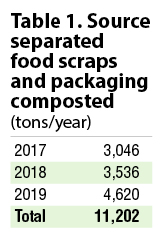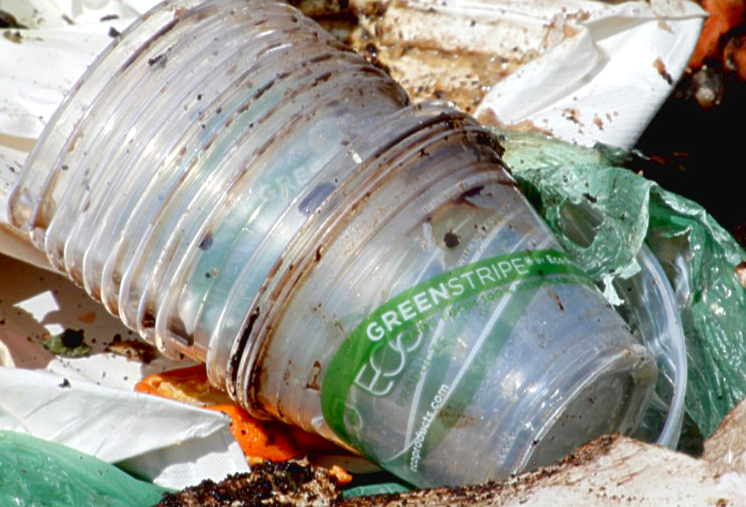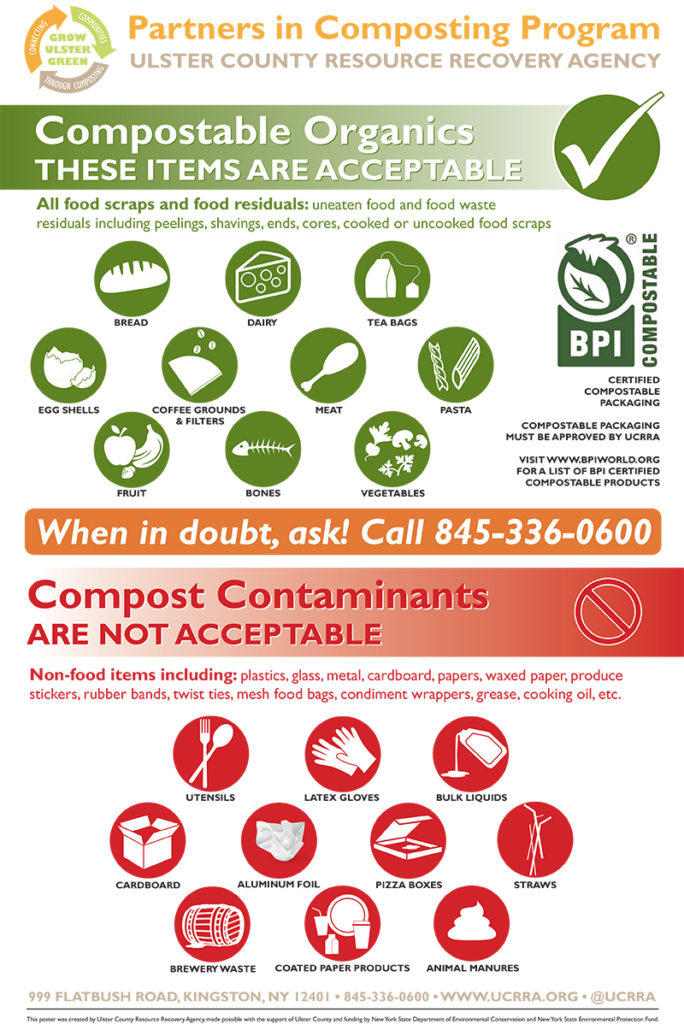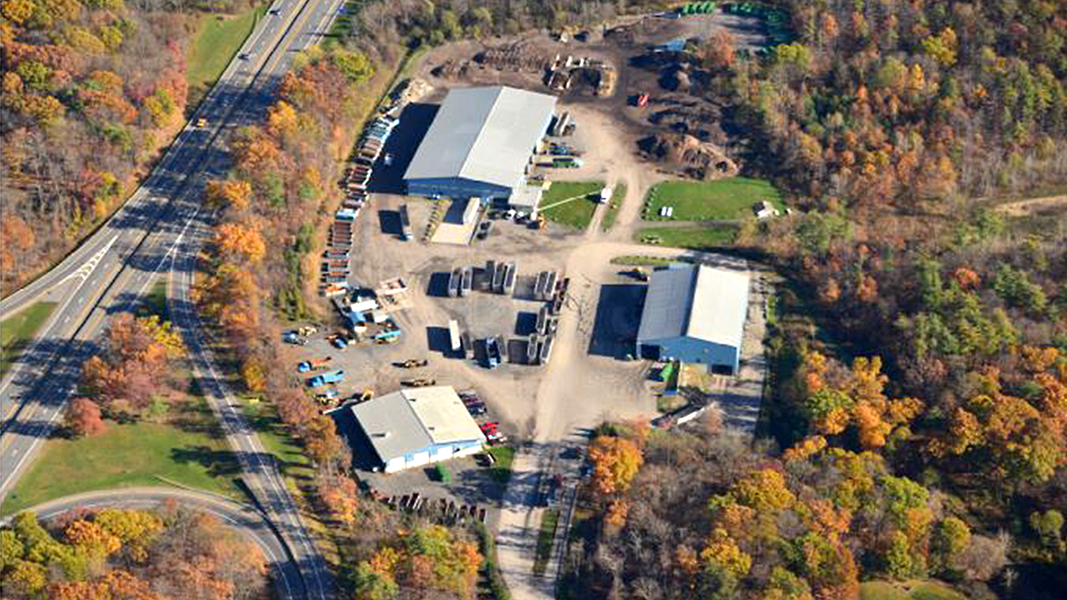Nora Goldstein
The Ulster County Resource Recovery Agency (UCRRA) in Kingston, New York, decided in 2012 that it wanted to pilot test composting of food waste. Discarded food comprised about 15 percent of the county’s commercial waste stream at the time. The pilot, which began in July 2012, was designed to evaluate processing food waste from large quantity waste generators in the county and determine the feasibility of a much larger composting operation. UCRRA received a permit from the New York State Department of Environmental Conservation (NYSDEC) to process 1,000 cubic yards (cy) of food waste and 10,000 cy of yard trimmings. The composting operation is at UCRRA’s materials recovery facility and transfer station.

UCRRA’s extended aerated static pile composting facility in Kingston, New York. Photos courtesy of UCRRA
For the pilot, UCRRA used the extended aerated static pile (EASP) composting method developed by O2 Compost. All types of food waste were accepted, along with certified compostable liners, soiled paper and compostable serviceware. Wood chips ground on-site were used as a bulking agent. The tipping fee for food waste was set at $50/ton, compared to the transfer station tipping fee of $100/ton. In addition to servicing food waste generators in Ulster County, the facility began receiving loads of food waste from outside of Ulster County. By 2016, about 50% of incoming food waste was from in-county generators; the other 50% came from neighboring counties as well as from generators in the neighboring states of Connecticut and Massachusetts. One of the attractions — the initial tipping fee of $50/ton had been reduced to $30/ton in 2013, and then $20/ton in 2014 to incentivize haulers to collect food waste. The fee at the transfer station increased slightly to $103/ton. Waste from the county is hauled to Seneca Meadows Landfill in Waterloo, New York, a 480-mile roundtrip.
In September 2016, UCRRA decided to expand its food waste composting facility, as it was receiving over 1,000 tons of food waste (see “County Expands Food Waste Composting Site”). The agency asked NYSDEC for permission to construct the expanded site and modified its permit to double its source separated organics capacity. The site’s composting activities are authorized under UCRRA’s facility permit through a modification. Thus it is considered a permitted site (vs. a registered facility under the NYSDEC regulations). The composting pad was expanded from a 40-ft by 90-foot area to a 90-ft by 125-ft area, increasing the number of aerated static pile zones from 5 to 12. The expanded capacity would enable the facility to process up to 2,500 tons/year of food waste “comfortably,” noted BioCycle’s 2017 article. Also in 2016, a separate 12-ft by 25-ft area was built for composting mortalities.
2020 Update

Angelina Peone, UCRRA’s recycling coordinator, provided an update on the Agency’s food waste composting facility — referred to as the “Organics Recovery Facility” — on a recent New Jersey Composting Council webinar. BioCycle followed up to learn more. Over the past few years, the flow of food waste has continued to grow (Table 1). About 30 to 35% comes from generators within Ulster County, less than 5% comes from neighboring states (Connecticut, New Jersey and Massachusetts), and the remainder is generated in neighboring counties. “The largest of those is Westchester County,” says Peone. While residential food waste may be in some of the commercial loads, the vast majority comes from the commercial sector — grocery stores, institutions, schools, restaurants, cafeterias, etc.
For in-county generators, UCRRA can provide 35-gallon carts, and offers training (and retraining) to establish the source separation programs. Out-of-county generators are surveyed to collect information about their facilities and who will be involved, and given customized feedback on how to set up the program. Planning tools are provided to all generators. “Everyone is invited to come for a tour of the composting facility,” explains Peone. “Walking around the site, seeing the incoming loads of food waste and how they are processed into high quality compost, builds understanding about the program in general, and drives home the reality that proper source separation is critical.” She notes that haulers are incentivized to eliminate contamination because fees are charged based on the estimated percentage of loads that are contaminated.
 Compostable products certified by the Biodegradable Products Institute (BPI) are accepted at the composting facility. Approval to include the products is done on a case-by-case basis and is specific to generator categories. “We accept them from schools and festivals, for example, where they serve as a very important piece of successful organics diversion,” says Peone. “We ask approved generators to email us photos of what they plan to use so we can check the product(s) out before they purchase them. We prefer use of molded fiber products because they break down more easily, but accept BPI-certified bioplastics. Certified compostable products really need to have an imprint, e.g., a green stripe, so that when the operator is on the front-end loader, they can look down and clearly tell that it is acceptable. For special events and festivals, it is critical that every piece of serviceware used is certified compostable. Otherwise, it is a nightmare when the materials get to our facility.”
Compostable products certified by the Biodegradable Products Institute (BPI) are accepted at the composting facility. Approval to include the products is done on a case-by-case basis and is specific to generator categories. “We accept them from schools and festivals, for example, where they serve as a very important piece of successful organics diversion,” says Peone. “We ask approved generators to email us photos of what they plan to use so we can check the product(s) out before they purchase them. We prefer use of molded fiber products because they break down more easily, but accept BPI-certified bioplastics. Certified compostable products really need to have an imprint, e.g., a green stripe, so that when the operator is on the front-end loader, they can look down and clearly tell that it is acceptable. For special events and festivals, it is critical that every piece of serviceware used is certified compostable. Otherwise, it is a nightmare when the materials get to our facility.”
 For the past 3 years, UCRRA has partnered with Ulster County on a Municipal Compost Expansion Grant Program offered by the NYS Climate Smart Communities Grant Program to increase UCRRA’s composting capacity; expand compost distribution and marketing; develop new program supplies for partners in the composting program, such as posters and guidebooks, and procure the 35-gallon organics totes; and demonstrate food waste recovery at county facilities, specifically the Ulster County Jail.
For the past 3 years, UCRRA has partnered with Ulster County on a Municipal Compost Expansion Grant Program offered by the NYS Climate Smart Communities Grant Program to increase UCRRA’s composting capacity; expand compost distribution and marketing; develop new program supplies for partners in the composting program, such as posters and guidebooks, and procure the 35-gallon organics totes; and demonstrate food waste recovery at county facilities, specifically the Ulster County Jail.
“Total project costs were $523,502,” says Peone. “We were able to acquire a 2019 Rotochopper bagging machine and bagging supplies to enhance compost distribution, as well as a new Phoenix 2100 trommel screen to increase efficiencies in our operation. The trommel gives the agency more flexibility with processing. It can screen 150 tons/hour of compost, whereas the old machine screened 10 tons/hour. Reduced materials handling cuts labor time and thus operating costs, and reduces agitating the compost and releasing any odors emanating from these processes. Compost is screened to one-eighth inch.”
Over the past three years, the organics recovery facility has sold about 5,300 tons of its STA-certified (Seal of Testing Assurance) finished compost (2017-2019) in bulk for use on farms, and in landscaping and gardens. “In May 2020, the Agency had hit a new milestone for selling out of compost,” says Peone. “In 2019, we sold out by the Fourth of July.”
Composting Operations
Wood chips are stockpiled in a designated storage area. Food waste is unloaded onto wood chips placed inside a horseshoe made from concrete partitions. The receiving area is on an asphalt pad and is about 26-ft by 40-ft. Operators aim for a mix of roughly 2.5:1 to 3:1 wood chips to food waste. For wetter loads, the ratio may increase to 4:1. All aeration pipes are above ground. A front-end loader moves the freshly mixed feedstocks to an open zone on the composting pad; each zone holds about 200 cy of material.
A Telestack MH5680 portable radial stacker manufactured by Emerald Equipment Systems was purchased this year. “The radial stacker enables the Agency to relocate large volumes of compost around the small footprint of our existing site in a manner that reduces fuel use and site traffic, while increasing safety around the composting facility,” explains Peone. “We also are using it to lay down a 6- to 8-inch biofilter cap on top of piles in the active composting zones. Applying the layer of finished compost or screened overs protects the surface of the pile from drying out, insulates the pile from heat loss, discourages flies or other nuisances, eliminates any food residuals that may be exposed on the surface of a pile, and aids in filtering ammonia and other volatile organic compounds that produce undesirable odors. Previously, we were unable to place the caps on the piles using loaders.”
The stacker also will play a role in bagging compost (the line is not operating yet) by conveying the compost in thin layers. “The compost can dry out as it is being moved and the machine reduces the bulk density of the material that will be loaded into the bags, resulting in a more desirable product with lower moisture content and bulk density,” she adds.
The active composting phase is 30 days, after which the compost is put into large windrows for up to 60 days of curing and maturation. The curing area is about 100-ft by 220-ft. Two UCRRA employees manage all aspects of the composting operation. The facility operates at a breakeven level, with tip fee and compost sales revenues offsetting operating costs.
In terms of avoided emissions, composting instead of exporting organics 480 miles roundtrip to the Seneca Meadows Landfill removed 320 tractor trailer vehicles from the road (2017-2019), representing a reduction of 153,600 miles and 30,400 gallons of diesel fuel, according to UCRRA statistics. Emissions avoidance from transportation represents 309.47 metric tons of carbon dioxide; the emissions avoidance from landfill disposal represents 728,139 kilograms of methane (2017-2019).
Future Expansion
In 2019, the New York State Food Donation and Food Scraps Recycling law was passed. The law becomes effective January 1, 2022 and applies to designated food scraps generators (DFSGs) — defined as generating ≥ 2 tons per week (annual average) at a single location. DFSGs must donate excess edible food and recycle all remaining food scraps if they are within 25 miles of an organics recycler (composting facility, anaerobic digester, etc.) that has capacity for all of the generator’s food scraps. The generator does not have to use an organics recycler within the 25-mile radius. UCRRA expects that demand for use of its organics recovery facility will grow.
The Agency recently purchased parcels of land — totaling 76 acres — adjacent to the current facility. Its Board of Directors hopes to expand the composting program, possibly even doubling the footprint of the current operation, in the near future. The expansion is referenced in UCRRA’s new 10-year Local Solid Waste Management Plan recently approved by NYSDEC. “The Agency is working with an engineering consultant to evaluate the feasibility and costs of a compost program expansion on the new parcel,” notes Peone.













